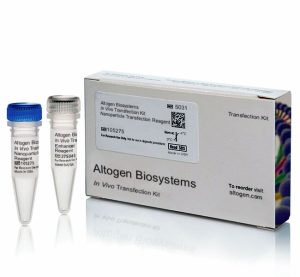Description
Purchase Orders: Click “Add to Cart” button to order, then email PO to orders@altogen.com.
Product Availability: In Stock.
NANOPARTICLE-based In Vivo Transfection Kit
Small RNA (si/shRNA, microRNA, mRNA) and plasmid DNA in vivo delivery reagent
Product Description:
Reagent for efficient delivery of therapeutic agents to heart, lung, liver, brain, pancreas, and multiple tumor types via tail vein administration. Functionally tested in mice and rats. Nanoparticles binds to cargo biomolecules and condense transfection complexes to enable efficient drug delivery and minimal toxicity (no significant changes in cytokine expression).
Altogen’s NANOPARTICLE In Vivo Transfection Reagent
- Efficient delivery to the brain, heart, lung, liver, pancreas, kidney, and multiple tumor types via tail vein administration
- Functionally tested in mice (BALB/c, Nude, NOD/SCID) and Sprague Dawley rats
- Complexes are stable in serum for 16 hours. Applicable for plasmid DNA and siRNA co-injection
- Efficient siRNA and pDNA delivery via direct subcutaneous tumor injection (various tumor types)
- Minimal toxicity. No significant change in cytokines expression and other safety biomarkers were observed
- Download NANOPARTICLE-based in vivo transfection protocol: [PDF] [Word]
- Download PowerPoint presentation for NANOPARTICLE-based in vivo transfection kit: [PPT]
- Download safety data sheet: [PDF]
- UPC/GTIN/EAN: 860002089702
-
Brand: ALTOGEN®, developed and manufactured by Altogen Biosystems
Modes of administration:
- Systemic intravenous (i.v.) injection
- Direct intratumoral (i.t.) injection
DATA
Brain transfection. Delivery of RNA and DNA biomolecules into the mouse brain tissue and glioblastoma brain tumor.
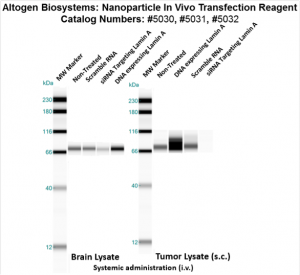
Figure 1. Systemic administration (i.v.) of Nanoparticle In Vivo Transfection Reagent conjugated with 80 ug of chemically modified siRNA targeting Lamin A/C mRNA or scrambled sequence non-silencing siRNA control (or pDNA expression vector encoding Lamin A) and following the recommended transfection protocol. Nanoparticle conjugated RNA/DNA complexes were injected at constant pressure into the tail veins of NOD/SCID mice (orthotopic glioblastoma xenograft model developed by Altogen Labs). Following 72 hours post first injection, the brain and brain tumor tissues were homogenized and lysed in RIPA Buffer supplemented with protease inhibitor cocktail. High sensitivity BCA protein assay was used to normalize the protein concentration from each individual sample. Quantitative immunoblotting was performed to analyze for the change in Lamin A expression levels using the automated western blot system WES (Protein Simple; San Jose, CA). Images acquired with the contrast set to white −100 and black 4000 for standardization. Mice treated with scrambled non-silencing siRNA served as controls. Statistical data analysis were conducted using Compass software. Technical replicates (n=10). Biological replicates (n=5). P-value < 0.01
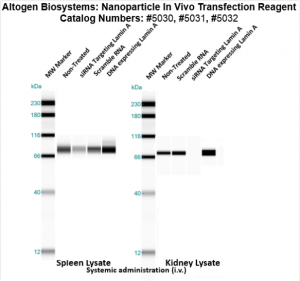
Figure 2. Intravenous administration of Nanoparticle In Vivo Transfection Reagent conjugated with 80 ug of chemically modified siRNA targeting Lamin A/C mRNA or scrambled sequence non-silencing siRNA control (or pDNA expression vector encoding Lamin A) and following the recommended transfection protocol. Nanoparticle conjugated RNA/DNA complexes were injected at constant pressure into the tail veins of NOD/SCID mice. Following 72 hours post first injection, the spleen and kidney tissues were homogenized and lysed in RIPA Buffer supplemented with protease inhibitor cocktail. High sensitivity BCA protein assay was used to normalize the protein concentration from each individual sample. Quantitative immunoblotting was performed to analyze for the change in expression of Lamin A using the automated western blot WES system. Images acquired with the contrast set to white −100 and black 4000 for standardization. Statistical data analysis were conducted using Compass software. Technical replicates (n=10). Biological replicates (n=5). P-value < 0.01 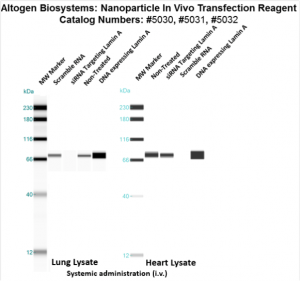
Figure 3. Intravenous administration of Nanoparticle In Vivo Transfection Reagent conjugated with 80 ug of chemically modified siRNA targeting Lamin A/C mRNA or scrambled sequence non-silencing siRNA control (or pDNA expression vector encoding Lamin A) and following the recommended transfection protocol. Nanoparticle conjugated RNA/DNA complexes were injected at constant pressure into the tail veins of NOD/SCID mice. Following 72 hours post first injection, the lung and heart tissues were homogenized and lysed in RIPA Buffer supplemented with protease inhibitor cocktail. High sensitivity BCA protein assay was used to normalize the protein concentration from each individual sample. Quantitative immunoblotting was performed to analyze for the change in expression of Lamin A using the automated western blot WES system. Images acquired with the contrast set to white −100 and black 4000 for standardization. Statistical data analysis were conducted using Compass software. Technical replicates (n=10). Biological replicates (n=5). P-value < 0.01 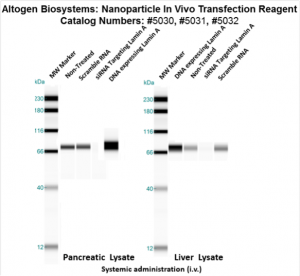
Figure 4. Intravenous administration of Nanoparticle In Vivo Transfection Reagent conjugated with 80 ug of chemically modified siRNA targeting Lamin A/C mRNA or scrambled sequence non-silencing siRNA control (or pDNA expression vector encoding Lamin A) and following the recommended transfection protocol. Nanoparticle conjugated RNA/DNA complexes were injected at constant pressure into the tail veins of NOD/SCID mice. Following 72 hours post first injection, the liver and pancreas tissues were homogenized and lysed in RIPA Buffer supplemented with protease inhibitor cocktail. High sensitivity BCA protein assay was used to normalize the protein concentration from each individual sample. Quantitative immunoblotting was performed to analyze for the change in expression of Lamin A using the automated western blot WES system. Images acquired with the contrast set to white −100 and black 4000 for standardization. Statistical data analysis were conducted using Compass software. Technical replicates (n=10). Biological replicates (n=5). P-value < 0.01

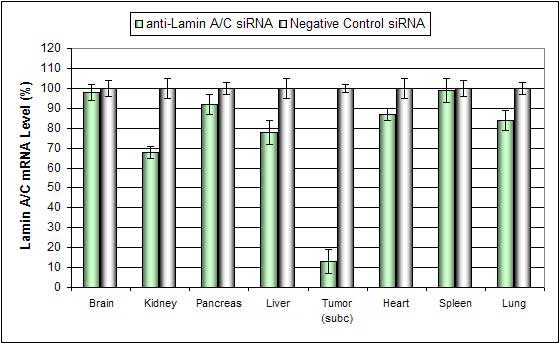
Figure 5. Systemic administration (i.v.) of Nanoparticle-based In Vivo reagent conjugated with siRNA targeting Lamin A/C mRNA or non-silencing control siRNA following the recommended protocol. Tissues were collected and RNA isolated 48 hours after post first injection. Samples were analyzed by qRT-PCR for Lamin A/C gene expression levels. Ribosomal RNA levels were used to normalize the Lamin A/C data. Data are means ± SD (n=6).
ALTOGEN® IN VIVO Transfection Kits supplied with ready-to-run transfection protocols that eliminate the need for extensive transfection optimization experiments. Read more about transfection technology at Altogen’s Transfection Resource.
Nanoparticle Transfection Reagent citation references:
- Nature Biotechnology. 2011 29(4):341-5. Delivery of siRNA to the mouse brain by … Alvarez-Erviti et al [PDF]
- Cardiovascular Research. 2016. 110(1):30-39. Modulators of right ventricular apoptosis and contractility in a rat model of pulmonary hypertension. Zungu-Edmondson et al et al [PDF]
- Hypertension 2015. 65(6):1307-15. Hypoxia-independent upregulation of placental hypoxia inducible factor-1 gene expression … Iriyama T et al [PDF]
- Diabetologia. 2015 Aug; 58(8): 1949–1958. Silencing of miR-195 reduces diabetic cardiomyopathy in C57BL/6 mice. Zheng et al [PDF]
- J Mol Cell Cardiol. 2015 Jan; 0: 174–185. Netrin-1 Abrogates Ischemia Reperfusion-induced Cardiac Mitochondrial Dysfunction via Nitric Oxide-dependent Attenuation of NOX4 Activation and Recoupling of NOS. Siu et al [PDF]
- J Cereb Blood Flow Metab. 2017 Jul;37(7):2359-2367. Inhibition of Src family kinases improves cognitive function after intraventricular hemorrhage or intraventricular thrombin. Liu et al [PDF]
- Nature Medicine. 2016 22, 1131–1139. The long noncoding RNA Chaer defines an epigenetic checkpoint in cardiac hypertrophy. Wang et al [PDF]
Use of nanoparticles for in vivo transfection
Nanoparticles have emerged as a promising platform for targeted drug delivery and tissue engineering. Nanoparticles effective for in vivo delivery are typically 1 – 20 nanometers in size and can be engineered to interact with specific cells or tissues, allowing for targeted delivery of therapeutic agents. In tissue engineering, nanoparticles can be used to promote the growth and differentiation of cells in a three-dimensional environment. For example, they can be incorporated into scaffolds that mimic the extracellular matrix of specific tissues, providing cues to cells that encourage them to differentiate into the desired cell type. Additionally, nanoparticles can be functionalized with specific ligands to target specific cells and tissues, improving the efficacy of tissue engineering strategies. In targeted drug delivery, nanoparticles are designed to accumulate in specific tissues, allowing for precise delivery of therapeutic agents. Also, nanoparticles can be coated with ligands that bind to receptors on the surface of cancer cells, allowing for targeted delivery of chemotherapy drugs.
Altogen Labs Preclinical Research Services:
Altogen Labs provides GLP compliant CRO services for preclinical research, IND applications, and drug development. Biology contract research services includes over 100 in-house validated xenograft models), development of stable cell lines in just 28 days, ELISA assay development, cell-based and tissue targeted RNAi studies, safety pharm/tox assays, and many other research laboratory studies (both preclinical efficacy and safety).
Volume Options:
- 0.5 ml – 10 injections (Catalog #5030)
- 1.5 ml – 30 injections (Catalog #5031)
- 8.0 ml – 160 injections (Catalog #5032)
- 25 ml – 50 rat injections or 500 mouse injections (Catalog #5033)
Purchase Orders: Click “Add to Cart” button to order, then email PO to orders@altogen.com.
Product Availability: In Stock.






